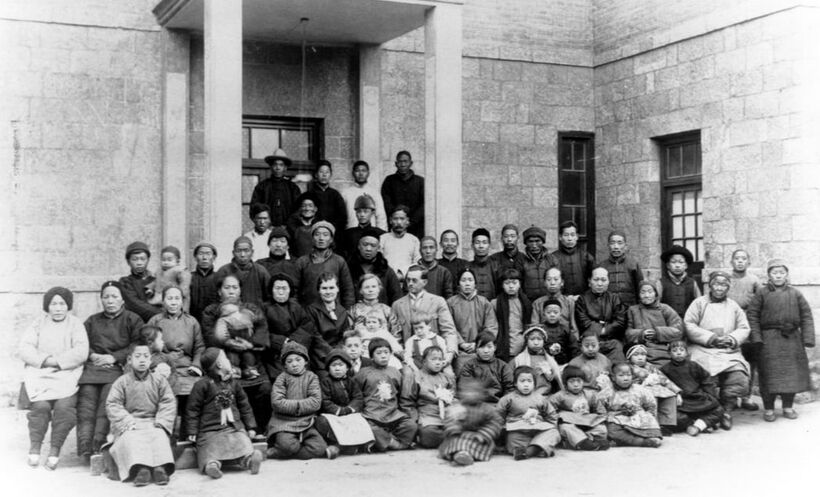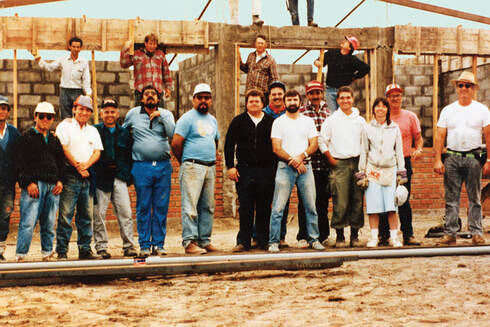FINISHING THE GREAT COMMISSION:
DIVISION OF WORLD EVANGELISM
David G. Roebuck
FINISHING JESUS' Great Commission to “Go into all the world and preach the gospel to every creature” (Mark 16:15 NJKV) is a vital imperative for the Church of God in every place and at every level of ministry. Local churches train and encourage members to share the good news; pastors and evangelists preach the gospel; state and regional offices facilitate church planting, assist struggling churches, and support evangelists; national and international offices appoint missionaries and provide resources; and other agencies partner to reach and care for the lost. The Division of World Evangelization provides support for these ministries and is organized into World Missions and Mission North America.
Our belief that the Father poured out the Holy Spirit to reach the harvest is essential to our commitment to finishing the Great Commission. The Feast of Pentecost was the Feast of Harvest, and early Pentecostals recognized that their fresh outpouring of the Holy Spirit was a supernatural enablement to reach the harvest in the last days.
The conviction that we are living in the last days has been a guiding motivation to finish the Great Commission. General Overseer A.J. Tomlinson wrote in the inaugural issue of the Church of God Evangel, “The command to go, the command to evangelize is just as forcible today upon us upon whom the ends of the world have come as it was when first uttered by our Lord and great Head of the Church.” Tomlinson continued, “The Holy Spirit was given to the disciples in the morning to give them power to accomplish just what they did accomplish. He is given to us today for the same purpose. We dare not falter. . . . The time is short. The harvest is ripe. The sickle must be furbished and put into use” (Evangel, March 1, 1910, 1).
Our belief that the Father poured out the Holy Spirit to reach the harvest is essential to our commitment to finishing the Great Commission. The Feast of Pentecost was the Feast of Harvest, and early Pentecostals recognized that their fresh outpouring of the Holy Spirit was a supernatural enablement to reach the harvest in the last days.
The conviction that we are living in the last days has been a guiding motivation to finish the Great Commission. General Overseer A.J. Tomlinson wrote in the inaugural issue of the Church of God Evangel, “The command to go, the command to evangelize is just as forcible today upon us upon whom the ends of the world have come as it was when first uttered by our Lord and great Head of the Church.” Tomlinson continued, “The Holy Spirit was given to the disciples in the morning to give them power to accomplish just what they did accomplish. He is given to us today for the same purpose. We dare not falter. . . . The time is short. The harvest is ripe. The sickle must be furbished and put into use” (Evangel, March 1, 1910, 1).
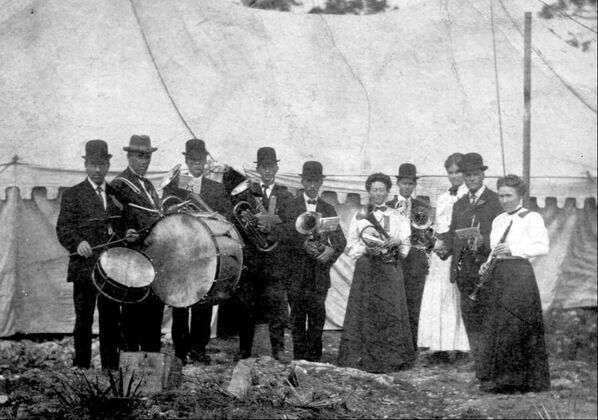 Tents and music have been key tools of evangelism. Here the Pentecostal World-wide Mission Band is
Tents and music have been key tools of evangelism. Here the Pentecostal World-wide Mission Band is preparing to travel to the Bahamas in 1911. A.J. Tomlinson (left) was the leader, and J.W. Buckalew
(second from right) was the music instructor.
Every Person a Witness
Evangelism was a dominant theme at the first General Assembly in 1906. Delegates shared reports and consecrated themselves to the harvest. According to the minutes, “After the consideration of the ripened fields and open doors for evangelism this year, strong men wept and said they were not only willing but really anxious to go.” The minutes recorded, “It is therefore the sense of this meeting that we do our best to press into every open door this year and work with greater zeal and energy for the spread of the glorious gospel of the Son of God than ever before” (Assembly Minutes).
Establishing a community presence is an essential element to planting a new congregation. The first Assembly recommended Sunday schools as an effective means to do this. They noted, “We believe a Sunday school may sometimes be organized and run successfully where a church could not be established at once, thereby opening and paving the way for more permanent work in the future” (Assembly Minutes).
The Church of God encouraged all Christians to put their sickles into the harvest. Insisting that evangelism is not just the responsibility of preachers, Tomlinson challenged the Assembly in 1911, “We have a number of workers who are not able to preach, but are willing to work at anything they can do. They are able to do personal work, hold cottage prayer meetings, distribute literature, and give ringing testimonies” (Assembly Minutes). Tomlinson especially believed that such workers could be crucial in establishing missions in cities that did not yet have a church.
This did not negate the importance of effective leadership. The 1911 General Assembly created the office of state overseer, whose first duty was to “conduct or order a general evangelistic campaign over his state during the year.” This office became an important means of establishing churches.
Tent campaigns and revivals also proved to be effective tools of evangelism. Few communities had facilities sufficient to plant a church or to hold a revival, so tents were a practical and portable way to provide inexpensive shelter for evangelistic services. Tents allowed for people to be receptive to the Holy Spirit. It was easier to attend a meeting outside one’s own tradition if the setting was not in a church building, and the uniqueness of a tent service held the audience’s attention in ways that the familiarly of a church building could not. The excitement of the tent meeting allowed worshipers to expect and be open to the new and unusual. The same could be said for brush arbors, which also were used in many places.
Passionate ministers of the gospel, Sunday schools, state overseers, tents, brush arbors, rented meeting halls, and dedicated workers all contributed to the fulfillment of the Great Commission. When General Overseer John C. Jernigan addressed the General Assembly in 1948, he reminded the delegates: “The Church of God has come to where it is today through toil and sacrifices. In the early days, when the brethren went out to hold revivals, there were no choirs, no church houses, and no money to sponsor therm. They either went singly or in small groups of workers, mostly inexperienced but full of fire and victory.” Jernigan continued: “One great method of advancing the work . . . was that members who received the baptism of the Holy Ghost in one community or town would move into another and begin a prayer meeting or Sunday School in a home, schoolhouse, union church house, or any place they could get a little group assembled. Then one of the few preachers they knew was invited over for a revival. The minister usually stayed in the home of a Church of God member who had recently moved into the community, fasted, prayed, and preached until the power fell.” Jernigan concluded: “Then when that stronghold was established, it became a bridgehead for further advancement, and members from that church usually took the light into other communities” (Assembly Minutes).
Evangelism was a dominant theme at the first General Assembly in 1906. Delegates shared reports and consecrated themselves to the harvest. According to the minutes, “After the consideration of the ripened fields and open doors for evangelism this year, strong men wept and said they were not only willing but really anxious to go.” The minutes recorded, “It is therefore the sense of this meeting that we do our best to press into every open door this year and work with greater zeal and energy for the spread of the glorious gospel of the Son of God than ever before” (Assembly Minutes).
Establishing a community presence is an essential element to planting a new congregation. The first Assembly recommended Sunday schools as an effective means to do this. They noted, “We believe a Sunday school may sometimes be organized and run successfully where a church could not be established at once, thereby opening and paving the way for more permanent work in the future” (Assembly Minutes).
The Church of God encouraged all Christians to put their sickles into the harvest. Insisting that evangelism is not just the responsibility of preachers, Tomlinson challenged the Assembly in 1911, “We have a number of workers who are not able to preach, but are willing to work at anything they can do. They are able to do personal work, hold cottage prayer meetings, distribute literature, and give ringing testimonies” (Assembly Minutes). Tomlinson especially believed that such workers could be crucial in establishing missions in cities that did not yet have a church.
This did not negate the importance of effective leadership. The 1911 General Assembly created the office of state overseer, whose first duty was to “conduct or order a general evangelistic campaign over his state during the year.” This office became an important means of establishing churches.
Tent campaigns and revivals also proved to be effective tools of evangelism. Few communities had facilities sufficient to plant a church or to hold a revival, so tents were a practical and portable way to provide inexpensive shelter for evangelistic services. Tents allowed for people to be receptive to the Holy Spirit. It was easier to attend a meeting outside one’s own tradition if the setting was not in a church building, and the uniqueness of a tent service held the audience’s attention in ways that the familiarly of a church building could not. The excitement of the tent meeting allowed worshipers to expect and be open to the new and unusual. The same could be said for brush arbors, which also were used in many places.
Passionate ministers of the gospel, Sunday schools, state overseers, tents, brush arbors, rented meeting halls, and dedicated workers all contributed to the fulfillment of the Great Commission. When General Overseer John C. Jernigan addressed the General Assembly in 1948, he reminded the delegates: “The Church of God has come to where it is today through toil and sacrifices. In the early days, when the brethren went out to hold revivals, there were no choirs, no church houses, and no money to sponsor therm. They either went singly or in small groups of workers, mostly inexperienced but full of fire and victory.” Jernigan continued: “One great method of advancing the work . . . was that members who received the baptism of the Holy Ghost in one community or town would move into another and begin a prayer meeting or Sunday School in a home, schoolhouse, union church house, or any place they could get a little group assembled. Then one of the few preachers they knew was invited over for a revival. The minister usually stayed in the home of a Church of God member who had recently moved into the community, fasted, prayed, and preached until the power fell.” Jernigan concluded: “Then when that stronghold was established, it became a bridgehead for further advancement, and members from that church usually took the light into other communities” (Assembly Minutes).

Providing National Leadership
Leadership of the Church of God began to recognize a need for more structure in our evangelistic thrust in the early 1950s. The 1956 General Assembly created a National Evangelism Committee to support evangelists and create programs to assist churches in revival. Then in 1963, the Executive Council created the Evangelism and Home Missions Department to coordinate and direct the numerous evangelism efforts of the church. The church appointed Walter R. Pettitt to serve as the first director of what is now included in a larger vision of Mission North America.
Ministries and organizational structure continually evolve as the Church of God develops strategies and opportunities to share the love of Christ. Among these have been published materials to assist in planning, promoting, and funding revivals, as well as specialty areas such as jail and prison ministries. It has promoted the appointment of state and national evangelists, and provided numerous training conferences and workshops to enhance evangelism ministries in local churches. In recent years, it has encouraged retired ministers with an annual Jubilee and established an office to facilitate local church amalgamations. In 2005, the Executive Committee established a National Church Planting Office, now Church Planting Network, under the leadership of Michael Knight to provide assessments and training for church planters. In 2018, Canada Vision 2020 under the leadership of Keith Ivester gave renewed emphasis to ministry north of the border, and in 2019 the Executive Committee appointed Mitchell E. Corder to provide leadership to the Office of Church Health and Revitalization.
Lay Evangelism
Soon after its establishment, the Evangelism and Home Missions Department began an emphasis on lay evangelism. A committee appointed in 1964 became the National Laymen’s Board by 1966 with J.D. Silver as chair. A Lay Affairs Office began in 1972 that developed into the Lay Ministries Department. Charles R. Beach served as its first executive director, and Leonard Albert became a field representative in 1974.
Beach and Albert brought extensive evangelism experience to their respective offices. While a faculty member at Lee College, Beach had developed the Pioneers for Christ Club, which provided evangelism training for students and served as a model that the denomination later adopted. Lay Ministries included Schools of Lay Evangelism, Lay Literature for the Lost, International Lay Witness Week, Resurrection Breakfasts, International Laymen’s Day, and Pastor Appreciation Day. Along with other structural changes in 2010, Albert’s leadership in personal evangelism was retained in the Division of World Evangelization while men’s ministries shifted to the Division of Discipleship.
Leadership of the Church of God began to recognize a need for more structure in our evangelistic thrust in the early 1950s. The 1956 General Assembly created a National Evangelism Committee to support evangelists and create programs to assist churches in revival. Then in 1963, the Executive Council created the Evangelism and Home Missions Department to coordinate and direct the numerous evangelism efforts of the church. The church appointed Walter R. Pettitt to serve as the first director of what is now included in a larger vision of Mission North America.
Ministries and organizational structure continually evolve as the Church of God develops strategies and opportunities to share the love of Christ. Among these have been published materials to assist in planning, promoting, and funding revivals, as well as specialty areas such as jail and prison ministries. It has promoted the appointment of state and national evangelists, and provided numerous training conferences and workshops to enhance evangelism ministries in local churches. In recent years, it has encouraged retired ministers with an annual Jubilee and established an office to facilitate local church amalgamations. In 2005, the Executive Committee established a National Church Planting Office, now Church Planting Network, under the leadership of Michael Knight to provide assessments and training for church planters. In 2018, Canada Vision 2020 under the leadership of Keith Ivester gave renewed emphasis to ministry north of the border, and in 2019 the Executive Committee appointed Mitchell E. Corder to provide leadership to the Office of Church Health and Revitalization.
Lay Evangelism
Soon after its establishment, the Evangelism and Home Missions Department began an emphasis on lay evangelism. A committee appointed in 1964 became the National Laymen’s Board by 1966 with J.D. Silver as chair. A Lay Affairs Office began in 1972 that developed into the Lay Ministries Department. Charles R. Beach served as its first executive director, and Leonard Albert became a field representative in 1974.
Beach and Albert brought extensive evangelism experience to their respective offices. While a faculty member at Lee College, Beach had developed the Pioneers for Christ Club, which provided evangelism training for students and served as a model that the denomination later adopted. Lay Ministries included Schools of Lay Evangelism, Lay Literature for the Lost, International Lay Witness Week, Resurrection Breakfasts, International Laymen’s Day, and Pastor Appreciation Day. Along with other structural changes in 2010, Albert’s leadership in personal evangelism was retained in the Division of World Evangelization while men’s ministries shifted to the Division of Discipleship.
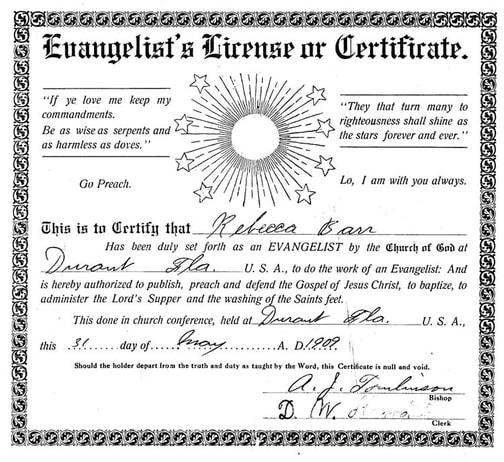
Multi-Cultural, African-American, and Hispanic Ministries
With an increasingly diverse population in North America, the Church of God has sought opportunities to minister to various cultures. Ministry to Native Americans in the Dakotas and North Carolina expanded to include tribes of the American Southwest. Starting in 1980, J.D. Golden inaugurated a variety of ministries in New York’s metropolitan area. Then in 1982, Billy J. Rayburn became a full-time director of Cross-Cultural Ministries. Later renamed Multi-Cultural Ministries with oversight and evangelism among Romanian, Indonesian, Portuguese, Filipino, and First Nations people groups. In 2018 Multi-Cultural and Back Ministries combined to form Intercultural Advancement Ministries under the leadership of Doyle P. Scott.
Black Americans have been members of the Church of God since at least 1909 when Bahamian Edmond Barr and his Georgia-born wife, Rebecca, joined in Durant, Florida. Reflecting the challenges of segregated America in 1915, General Overseer Tomlinson appointed Bishop Barr as overseer of the Black churches. Beginning with Thomas J. Richardson in 1922, the church appointed black overseers at a national level until 1958. Black churches held a national “Colored” Assembly from 1926 until 1966. While black and white churches have served under the same overseers in most states since 1966, black leaders in Florida requested to continue a separate office.
As the Church of God advanced beyond the vestiges of segregation, we began to appoint black leaders to regional and national posts leading to establishing an office of Black Ministries. Among those leaders were Black Liaison H.G. Poitier and Southeastern Regional Evangelism Director Wallace Sibley Sr. In 1992, Joseph E. Jackson became director of Black Ministries. Then in 2008, Bishop Sibley was elected for the first of two terms as secretary general, making him the first non-Caucasian elected to the Executive Committee.
Our first Spanish-language congregation came into the Church of God in Raton, New Mexico, in 1911 under the leadership of Evangelist R.M. Singleton and Pastor T.F. Chavez. In 1945, we created a Latin-American Department to give oversight to Latin American ministries at home and abroad. The department published El Evangelio de la Iglesia de Dios and established the International Preparatory Institute in San Antonio. Texas native and missionary to Mexico, Vessie D. Hargrave, served as the first director. The first National Hispanic Conference was in 1985 with the theme, “That They All May Be One.” The Church of God established the Office of Hispanic Ministries in 1992 and appointed Esdras Betancourt to oversee this flourishing ministry. Hispanic ministry in the United States is now divided into eight regions, and Editorial Evangelica partners with Church of God Publications.
Freedom Outreach: A Ministry to the Military
In addition to the Chaplains Commission, the Church of God ministers to men and women in uniform through Freedom Outreach: A Ministry to the Military. Early efforts to minister to soldiers during World War II included the commissioning of U.D. Tidwell to send letters and phonograph recordings to those in uniform; Frank W. Lemons traveling from base to base for worship and personal ministry; publishing and distributing Strength for Service; and sending The Lighted Pathway to armed forces. Additionally, there were countless efforts by congregations located near military personnel.
A dream of organized ministry to military personnel was born in the heart of J. Don Amison. Having served in Germany as pastor of a congregation that ministered to soldiers, Amison recognized this need. By 1961, he had established an office and began publishing On Guard. Meanwhile, the Church of God appointed Assistant General Overseer H.D. Williams as the first director of the Servicemen’s Department, which was renamed Ministry to the Military in 1982. As part of Mission North America, Freedom Outreach operates Ministry Centers around the world and encourages congregations located near military installations to embrace service personnel.
With an increasingly diverse population in North America, the Church of God has sought opportunities to minister to various cultures. Ministry to Native Americans in the Dakotas and North Carolina expanded to include tribes of the American Southwest. Starting in 1980, J.D. Golden inaugurated a variety of ministries in New York’s metropolitan area. Then in 1982, Billy J. Rayburn became a full-time director of Cross-Cultural Ministries. Later renamed Multi-Cultural Ministries with oversight and evangelism among Romanian, Indonesian, Portuguese, Filipino, and First Nations people groups. In 2018 Multi-Cultural and Back Ministries combined to form Intercultural Advancement Ministries under the leadership of Doyle P. Scott.
Black Americans have been members of the Church of God since at least 1909 when Bahamian Edmond Barr and his Georgia-born wife, Rebecca, joined in Durant, Florida. Reflecting the challenges of segregated America in 1915, General Overseer Tomlinson appointed Bishop Barr as overseer of the Black churches. Beginning with Thomas J. Richardson in 1922, the church appointed black overseers at a national level until 1958. Black churches held a national “Colored” Assembly from 1926 until 1966. While black and white churches have served under the same overseers in most states since 1966, black leaders in Florida requested to continue a separate office.
As the Church of God advanced beyond the vestiges of segregation, we began to appoint black leaders to regional and national posts leading to establishing an office of Black Ministries. Among those leaders were Black Liaison H.G. Poitier and Southeastern Regional Evangelism Director Wallace Sibley Sr. In 1992, Joseph E. Jackson became director of Black Ministries. Then in 2008, Bishop Sibley was elected for the first of two terms as secretary general, making him the first non-Caucasian elected to the Executive Committee.
Our first Spanish-language congregation came into the Church of God in Raton, New Mexico, in 1911 under the leadership of Evangelist R.M. Singleton and Pastor T.F. Chavez. In 1945, we created a Latin-American Department to give oversight to Latin American ministries at home and abroad. The department published El Evangelio de la Iglesia de Dios and established the International Preparatory Institute in San Antonio. Texas native and missionary to Mexico, Vessie D. Hargrave, served as the first director. The first National Hispanic Conference was in 1985 with the theme, “That They All May Be One.” The Church of God established the Office of Hispanic Ministries in 1992 and appointed Esdras Betancourt to oversee this flourishing ministry. Hispanic ministry in the United States is now divided into eight regions, and Editorial Evangelica partners with Church of God Publications.
Freedom Outreach: A Ministry to the Military
In addition to the Chaplains Commission, the Church of God ministers to men and women in uniform through Freedom Outreach: A Ministry to the Military. Early efforts to minister to soldiers during World War II included the commissioning of U.D. Tidwell to send letters and phonograph recordings to those in uniform; Frank W. Lemons traveling from base to base for worship and personal ministry; publishing and distributing Strength for Service; and sending The Lighted Pathway to armed forces. Additionally, there were countless efforts by congregations located near military personnel.
A dream of organized ministry to military personnel was born in the heart of J. Don Amison. Having served in Germany as pastor of a congregation that ministered to soldiers, Amison recognized this need. By 1961, he had established an office and began publishing On Guard. Meanwhile, the Church of God appointed Assistant General Overseer H.D. Williams as the first director of the Servicemen’s Department, which was renamed Ministry to the Military in 1982. As part of Mission North America, Freedom Outreach operates Ministry Centers around the world and encourages congregations located near military installations to embrace service personnel.
|
|
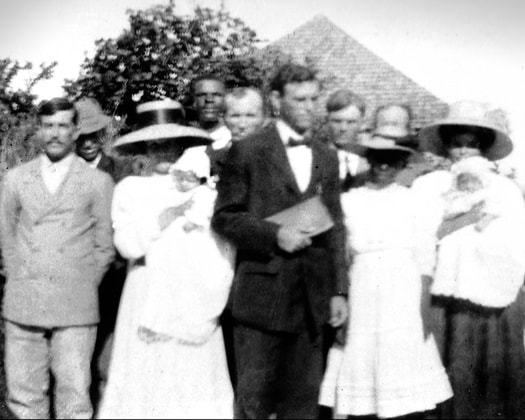 Carl M. Padgett, standing center with Bible, set in order the Green Turtle Cay church in the
Carl M. Padgett, standing center with Bible, set in order the Green Turtle Cay church in the Bahamas in 1913. It is the oldest continuing Church of God outside the United States.
Reaching a Global Harvest
As the Church of God became firmly established in Cleveland, Tennessee, the Holy Spirit compelled us to look toward a world harvest. When Edmond and Rebecca Barr came into the Church of God in 1909, they felt an urgency to return to his homeland in the Bahamas and set sail in November. Retired minister R.M. Evans and his wife Ida also felt the call. After selling their own possessions to finance the trip, the Evanses joined the Barrs in Nassau in January 1910, accompanied by Carl M. Padgett.
Church of God missions efforts remained largely unorganized for several years. Missionaries went on their own and sometimes represented the Pentecostal message rather than any one organization. The Church of God supported several such missionaries, including Lillian Trasher in Assiout, Egypt, in 1910.
Many other missionary endeavors followed. Jennie Brinson Rushin traveled to China in 1914. F.L. Ryder sailed to the Virgin Islands where he established a church before traveling on to South America in 1917. Lucy M. Leatherman was the first Church of God missionary to Chile in 1917. Strategic efforts included Maria Atkinson to Mexico in 1931, and Herman Lauster to his home in Germany in 1936. Robert F. Cook brought his India mission into the Church of God in 1936, and Paul C. Pitt’s China mission came into our movement in 1937. When Edmond and Pearl Stark went to Angola in 1938, he became stricken with malaria and died. Yet, the burden for Angola was not buried with him. Pearl Stark returned alone in 1947 to minister the gospel.
Both fundraising and organizational structure gradually developed so that the Church of God could expand our missions ministries. The first recorded local church missions offering was $7.00 received by the Arcadia, Florida, church in April 1910. The first Assembly offering for missions was $21.05 received in 1911 to send to the Evanses in the Bahamas. General Assemblies in 1913 and 1914 approved systematic plans to raise support for missionaries. The 1914 plan for congregations to collect monthly offerings was modified in 1927 when local churches covenanted to raise offerings equal to 5 percent of their tithes to be divided between home and world missions. This financial strategy remained in effect until the reallocation of resources in 2010 with local churches now sending 1.25 percent of the tithe funds they receive to support Church of God World Missions. While support for missionaries and special projects most often comes directly from local congregations, monies churches send to sustain the International Offices provide for administrative oversight.
Beginning in 1911, each Assembly appointed a Missions Committee to make recommendations. A standing board replaced this committee in 1926. Then in 1936, the Church of God appointed J.H. Ingram as a foreign missions field representative. That year, Ingram embarked on a “Golden Jubilee Tour” to commemorate the fiftieth anniversary of the Church of God and traveled 44,000 miles visiting thirty-one countries and colonies. M.P. Cross became the first full-time World Missions executive secretary (director) in 1942, and then area superintendents were appointed beginning in 1945 with Carl J. Hughes as superintendent of Bermuda and the West Indies and Vessie D. Hargrave as superintendent of Latin America. Today, field directors oversee major regions outside the United States.
Since 1966, Church of God membership in missions areas has surpassed that of the United States and Canada, due in part to affiliation and amalgamation with national churches. For example, the Apostolic Pentecostal Church of God in Romania began in 1922 when Sida Bradin was miraculously healed. She and her husband, George, had read a tract on divine healing and established a church in their home based on the doctrines of the Church of God. Although political and religious circumstances made communication between Romania and the United States difficult, with the fall of communism, ties were reestablished in 1980. Other partnerships include amalgamation with the Full Gospel Church of God in South Africa in 1951 and the Bethel Full Gospel Church in Indonesia in 1967.
The vision for world harvest has long been more than just a vision of North Americans; countries that were mission fields are becoming mission forces. Among innumerable illustrations, Korean missionaries have established the Church of God in Nepal; South Americans have sent missionaries to Russia; Church of God members in Indonesia have planted churches in China; and Word for the World in the Philippines has established congregations among Filipinos in many nations, including the United States.
A crucial strategy for reaching the whole world in the twenty-first century is our commitment to unreached people groups. Defined as a group of people among whom few, if any, have ever heard the gospel, the Church of God has now has active ministry to more than seventy of these groups.
Today Church of God ministries are in 185 countries and territories, including more than 7,000,000 members. May we too have the passion and dedication of those who have gone before us. May our prayers join with that of A.J. Tomlinson who cried: “Oh, for a million men [and women] who would fear nothing but God, filled with such holy zeal and Godly courage, that we could all together burst forth under the power of this mighty baptismal fire and rush to every quarter of the globe like mad men, declaring the gospel of the Son of God, until every tribe, kindred, tongue and people could hear, and thus end this Last Great Conflict!” (Tomlinson, 219).
As the Church of God became firmly established in Cleveland, Tennessee, the Holy Spirit compelled us to look toward a world harvest. When Edmond and Rebecca Barr came into the Church of God in 1909, they felt an urgency to return to his homeland in the Bahamas and set sail in November. Retired minister R.M. Evans and his wife Ida also felt the call. After selling their own possessions to finance the trip, the Evanses joined the Barrs in Nassau in January 1910, accompanied by Carl M. Padgett.
Church of God missions efforts remained largely unorganized for several years. Missionaries went on their own and sometimes represented the Pentecostal message rather than any one organization. The Church of God supported several such missionaries, including Lillian Trasher in Assiout, Egypt, in 1910.
Many other missionary endeavors followed. Jennie Brinson Rushin traveled to China in 1914. F.L. Ryder sailed to the Virgin Islands where he established a church before traveling on to South America in 1917. Lucy M. Leatherman was the first Church of God missionary to Chile in 1917. Strategic efforts included Maria Atkinson to Mexico in 1931, and Herman Lauster to his home in Germany in 1936. Robert F. Cook brought his India mission into the Church of God in 1936, and Paul C. Pitt’s China mission came into our movement in 1937. When Edmond and Pearl Stark went to Angola in 1938, he became stricken with malaria and died. Yet, the burden for Angola was not buried with him. Pearl Stark returned alone in 1947 to minister the gospel.
Both fundraising and organizational structure gradually developed so that the Church of God could expand our missions ministries. The first recorded local church missions offering was $7.00 received by the Arcadia, Florida, church in April 1910. The first Assembly offering for missions was $21.05 received in 1911 to send to the Evanses in the Bahamas. General Assemblies in 1913 and 1914 approved systematic plans to raise support for missionaries. The 1914 plan for congregations to collect monthly offerings was modified in 1927 when local churches covenanted to raise offerings equal to 5 percent of their tithes to be divided between home and world missions. This financial strategy remained in effect until the reallocation of resources in 2010 with local churches now sending 1.25 percent of the tithe funds they receive to support Church of God World Missions. While support for missionaries and special projects most often comes directly from local congregations, monies churches send to sustain the International Offices provide for administrative oversight.
Beginning in 1911, each Assembly appointed a Missions Committee to make recommendations. A standing board replaced this committee in 1926. Then in 1936, the Church of God appointed J.H. Ingram as a foreign missions field representative. That year, Ingram embarked on a “Golden Jubilee Tour” to commemorate the fiftieth anniversary of the Church of God and traveled 44,000 miles visiting thirty-one countries and colonies. M.P. Cross became the first full-time World Missions executive secretary (director) in 1942, and then area superintendents were appointed beginning in 1945 with Carl J. Hughes as superintendent of Bermuda and the West Indies and Vessie D. Hargrave as superintendent of Latin America. Today, field directors oversee major regions outside the United States.
Since 1966, Church of God membership in missions areas has surpassed that of the United States and Canada, due in part to affiliation and amalgamation with national churches. For example, the Apostolic Pentecostal Church of God in Romania began in 1922 when Sida Bradin was miraculously healed. She and her husband, George, had read a tract on divine healing and established a church in their home based on the doctrines of the Church of God. Although political and religious circumstances made communication between Romania and the United States difficult, with the fall of communism, ties were reestablished in 1980. Other partnerships include amalgamation with the Full Gospel Church of God in South Africa in 1951 and the Bethel Full Gospel Church in Indonesia in 1967.
The vision for world harvest has long been more than just a vision of North Americans; countries that were mission fields are becoming mission forces. Among innumerable illustrations, Korean missionaries have established the Church of God in Nepal; South Americans have sent missionaries to Russia; Church of God members in Indonesia have planted churches in China; and Word for the World in the Philippines has established congregations among Filipinos in many nations, including the United States.
A crucial strategy for reaching the whole world in the twenty-first century is our commitment to unreached people groups. Defined as a group of people among whom few, if any, have ever heard the gospel, the Church of God has now has active ministry to more than seventy of these groups.
Today Church of God ministries are in 185 countries and territories, including more than 7,000,000 members. May we too have the passion and dedication of those who have gone before us. May our prayers join with that of A.J. Tomlinson who cried: “Oh, for a million men [and women] who would fear nothing but God, filled with such holy zeal and Godly courage, that we could all together burst forth under the power of this mighty baptismal fire and rush to every quarter of the globe like mad men, declaring the gospel of the Son of God, until every tribe, kindred, tongue and people could hear, and thus end this Last Great Conflict!” (Tomlinson, 219).
MISSION PARTNERS
|
Numerous other Church of God ministries work alongside the Division of World Evangelization as we “go into all the world.” Among these are:
Youth and Discipleship established Youth World Evangelism Action (YWEA) in 1957. Each year youth tackle a project such as building training centers, local churches, or educational institutions. Men and Women of Action sponsor teams of volunteers for construction, disaster relief, short-term missions, and personal evangelism. Inaugurated under the leadership of Robert D. Pace, the first team remodeled England’s Overstone College in 1984. Mission North America provides oversight of Men and Women of Action. Serving Orphans Worldwide, located in Bristol, Tennessee, joins with struggling children’s homes to help them move beyond survival and toward self-sustainability. This vision was birthed in the hearts of Gene D. Rice, John D. Nichols, and John Gregory. Due to their efforts, in 1998 the General Assembly raised an offering of $2.7 million, and John Gregory’s Lazarus Foundation contributed an additional $2.3 million. These initial funds assisted sixty orphanages. |
David G. Roebuck, Ph.D. is director of the Dixon Pentecostal Research Center, Church of God Historian,
and Assistant Professor of the History of Christianity at Lee University.
and Assistant Professor of the History of Christianity at Lee University.

